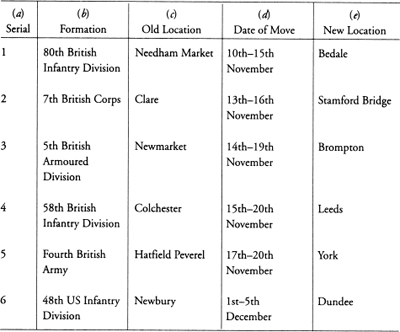
6th November, 1944
INDEX
| Pages | |
| Special Means Plan for the Regrouping of Notional Order of Battle in the United Kingdom | 1 and 2 |
| Appendix | |
| Order of Battle at 8th September, 1944 | ‘A’ |
| Order of Battle 9th–25th September, 1944 | ‘B’ |
| Order of Battle at 10th October, 1944 | ‘C’ |
| Order of Battle at 1st November, 1944 | ‘D’ |
| Order of Battle after 15th November, 1944 | ‘E’ |
| Movements of Forces | ‘F’ |
1. Fourth British Army was moved in July 1944 from Scotland to South-East England in order to support the threat to the Pas de Calais under FORTITUDE SOUTH II. The continued presence of Fourth British Army in South-East England, after the capture of the Pas de Calais at the beginning of September, coupled with the creation of a notional airborne force in the United Kingdom provided the latent threat of a combined airborne and seaborne operation against Denmark or the North-West German ports. As time passes it becomes increasingly difficult to explain why certain airborne divisions are employed in successive operations on the Continent while other fresh divisions in the United Kingdom remain uncommitted, also to explain why it should be necessary to reinforce 21 Army Group with American Divisions when there are still a number of British Field Divisions in the United Kingdom.
Future planning requires that a force should remain in the United Kingdom capable of exerting at short notice a threat against the North-West German ports. On the other hand a continuation of the status quo begins to present an unreal picture.
Object
2. To retain in the United Kingdom a force, plausible in the eyes of the Germans, and capable of exerting at short notice a threat to the North-West German ports.
Order of Battle
3. Notional order of battle of field forces in the United Kingdom supporting FORTITUDE SOUTH II is at Appendix ‘A’.
4. On the termination of FORTITUDE SOUTH II on 8th September, 1944, Fourteenth United States Army ceased to be under command First United States Army Group and came under SHAEF control. First Allied Airborne Army with a notional increment came under command First United States Army Group. (Order of Battle is at Appendix ‘B’.)
5. During the period 25th September-7th October the following regroupings occurred:
6. During October, First United States Army Group was disbanded. First Allied Airborne Army and the real formations under command reverted to SHAEF control, while the notional airborne formations, under a notional airborne force Headquarters came under command of Fourth British Army. As part of this regrouping 17 US Airborne Division ceased to be under command XVII Corps. Shortly after the disbandment of First US Army Group, Fourteenth US Army was also disbanded. (Order of Battle and locations are at Appendix ‘D’.) NOTE. See also last paragraph of story.
Story
7. The capture of the Pas de Calais by 21 Army Group rendered the seaborne assault by First US Army Group unnecessary. During the first weeks of September it appeared that the total defeat of Germany was imminent. First United States Army Group was therefore allotted a new role in support of the final breakthrough. First Allied Airborne Army was placed under command First US Army Group and Fourteenth US Army reverted to SHAEF control. The airborne attack on Arnhem constituted the first phase of a major assault from the United Kingdom. Had this attack succeed ed, a combined airborne and seaborne assault would have been launched by Fourth British Army supported by the remaining air borne divisions of First Allied Airborne Army, the whole force operating under the control of First US Army Group. After the setback at Arnhem and the general stabilisation on the Western Front, it was realised that an Allied victory in 1944 was unattainable. In these circumstances the operation of Fourth British Army and the Special Airborne Force was held in suspense. At about this time certain important policy decisions affecting the allocation of United States and British forces in all theatres were made by the Combined Chiefs of Staff. In view of impending British commitments in the Far East, a situation was envisaged where British forces might have to be withdrawn from the European Theatre, and replaced, if necessary, by additional United States forces. It was realised that this might involve an enlargement of the American and a reduction of the British zone. It was laid down that, so far as possible, formations which had no service overseas should be chosen for the Pacific Theatre.
In these circumstances a regrouping of forces is being carried out in the United Kingdom. 7 Corps will move to Yorkshire and there continue to train for the operations referred to above. It will also be available to satisfy British requirements in Burma and the Far East at short notice. 55 and 61 British Infantry Divisions will shortly come under control GHQ, Home Forces as draft-finding formations. When this occurs, 17 Corps Headquarters will become available for employment elsewhere. Special Airborne Force Headquarters and XVII US Airborne Corps will be disbanded. 9 and 21 US Airborne Divisions will be in part cannibalised, and in part will form the nucleus of a new airborne division. 19 British Airborne Corps will remain with under command 2 British Airborne Division and any other airborne formations that may subsequently be made available. Fourth British Army will be incorporated in Northern Command and will be available to command 7 Corps and 19 Airborne Corps, for the execution of the operation now held in suspense. The seaborne element in this force will sail from the Humber.
During October, certain other regroupings occurred which did not become known until November. These were as follows: XXXIII Corps was disbanded. 11, 17 and 48 US Infantry Divisions came under command British Base Section. The two former moved to the South Wales area and became draft-finding divisions, the latter will move shortly to Scotland and will continue its airborne training in the Dundee area.
Plan
8. Notional forces in the United Kingdom will be regrouped as shown at Appendix ‘E’ in accordance with the story at paragraph 7.
APPENDIX A TO SPECIAL MEANS PLAN DATED 6TH NOVE ORDER OF BATTLE AT 8TH SEPTEMBER, 1944

APPENDIX B TO SPECIAL MEANS PLAN DATED 6TH NOVE ORDER OF BATTLE – 9TH SEPTEMBER-25TH SEPTEMB
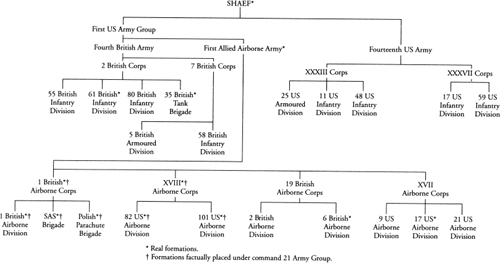
APPENDIX C TO SPECIAL MEANS PLAN DATED 6TH NOVE ORDER OF BATTLE AT 10TH OCTOBER, 1944
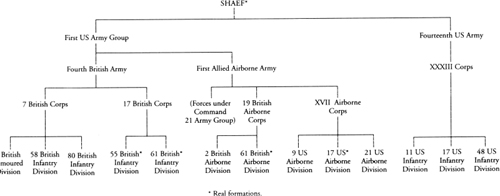
APPENDIX D TO SPECIAL MEANS PLAN DATED 6TH NOVE ORDER OF BATTLE AT 1ST NOVEMBER, 1944
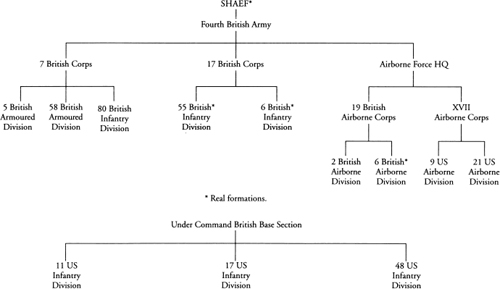
APPENDIX E TO SPECIAL MEANS PLAN DATED 6TH NOV ORDER OF BATTLE AT 15TH NOVEMBER, 19
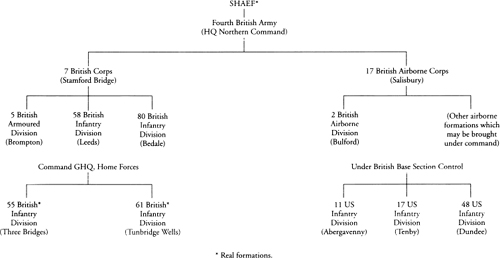
9. Forces will be located and notional troop movements will be carried out as shown at Appendix ‘F’.
APPENDIX F TO SPECIAL MEANS PLAN DATED 6TH NOVEMBER, 1944 MOVEMENTS OF FORCES
